Last Updated on January 17, 2024 by Greg Gillson
Did you see a brightly-colored red bird, orange bird, or yellow bird in Pennsylvania and wonder what is was?
This page is for you!
This article shows you photos and identification of some of the most common birds in Pennsylvania based on color.
The list of birds found in Pennsylvania includes over 450 species. So, I can’t show you all of them. I’m going to assume that you saw a common bird of this color, but you certainly could have seen something less common, or even rare!
Shape (including the shape of the bill) and size are often more helpful in starting to identify a bird than the color. In fact, most birds in North American can be easily identified with a black-and-white photo!
Many birds are multi-colored, so that it may be hard to pick out a dominant color. Males and females may be colored quite differently. And some color patterns are similar among otherwise dissimilar species.
Nevertheless, I’m going to try to pick out some of the birds that you are most likely to see in backyards or towns. And I’ll show a few others that I get asked about a lot.
The birds with a noticeable amount of red on them in Pennsylvania covered in this article are:
- Northern Cardinal
- American Robin
- House Finch
- Ruby-throated Hummingbird
- Scarlet Tanager
- Rose-breasted Grosbeak
- Purple Finch
- Ruddy Duck
The birds with a noticeable amount of orange on them in Pennsylvania covered in this article are:
- Eastern Towhee
- Barn Swallow
- Wood Thrush
- Baltimore Oriole
- American Redstart
- Brown Thrasher
- Red-breasted Nuthatch
- Orchard Oriole
- Red-shouldered Hawk
The birds with a noticeable amount of yellow on them, including lots of yellow and black birds, in Pennsylvania covered in this article are:
- American Goldfinch
- Northern Flicker
- Common Yellowthroat
- Cedar Waxwing
- Yellow Warbler
- Yellow-rumped Warbler
- Great Crested Flycatcher
- Magnolia Warbler
- Hooded Warbler
- Pine Siskin
- Eastern Meadowlark
- Yellow-throated Vireo
Red birds of Pennsylvania
Birds get the red, orange, and yellow in their feathers from carotenoids in the fruit, seeds, and plants they eat (source).
These carotenoid colors combine with melanin to form an infinite range of red feathers–pink, rusty, scarlet, violet, red-orange.
The following are red birds that you are most likely to see in Pennsylvania.
Northern Cardinal
These are one of the most common backyard birds in the eastern United States. Their bright red color and unique head profile makes them instantly identifiable to most people–whether they are bird watchers or not!
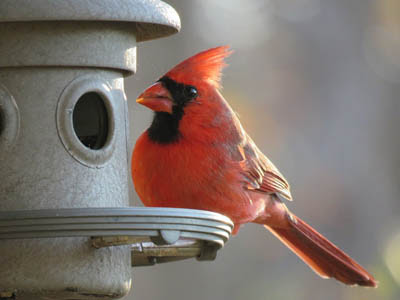 |
| Northern Cardinal. GeorgeB2 from Pixabay. |
Males of these large seed eaters are bright red with a black face and red crest.
Females replace most of the red with brown, The bill is large and orange.
These birds are found in woodlands, stream edges, residential areas.
Northern Cardinals are year-round residents throughout Pennsylvania.
American Robin
These are familiar lawn birds with red breasts.
 |
| American Robin. Greg Gillson. |
Male American Robins are brownish-gray above with a brick red breast. Females are paler orange below and paler gray above.
They are widespread in open country with scattered deciduous trees, residential areas.
American Robins are year-round residents throughout Pennsylvania.
House Finch
When people ask about a bird with a red head at their feeder, it is usually this bird.
 |
| Male House Finch. Greg Gillson. |
Males of this dusty brown striped finch have red limited to the head (specifically the forehead and eyebrow), breast (chest), and rump. The red coloration tends toward orangish, and may rarely be yellowish.
Females are streaked, similar to the males but without red. They lack any strong pattern on the face and head.
Note the small round head and curved upper ridge on the bill.
Some people call these red-headed sparrows. Sparrows and finches are similar, but in general, male finches are brighter than the females and tend to hang out more in trees. Sparrow genders are usually quite similar in coloration and tend to feed mostly on the ground.
These birds are common in residential areas, especially at bird feeders. In the West more widespread in arid regions near water.
House Finches are year-round residents throughout Pennsylvania.
Ruby-throated Hummingbird
These red-throated birds are the only hummingbird nesting in the eastern United States.

Males are dark green above and on the belly. They have a white upper chest. The throat is ruby-red.
Females are green above, white below, including white throat.
These birds are found in woodland edges, residential yards. Readily come to hummingbird feeders.
Ruby-throated Hummingbirds are summer residents throughout Pennsylvania.
Scarlet Tanager
A brilliant red and black bird!
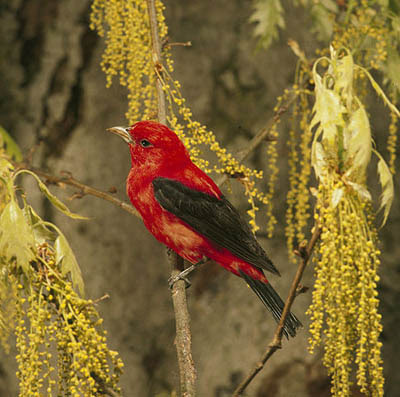 |
| Male Scarlet Tanager. USF&WS. Public Domain. |
Males are unmistakable with brilliant red with black wings and tail.
Females are olive-green above, darker wings and tail, yellower under parts. Pale bill.
These birds live in deciduous woods.
Scarlet Tanagers are summer residents throughout Pennsylvania.
Rose-breasted Grosbeak
These birds with the red breast and huge pink bill sing beautiful robin-like songs from the tops of trees.
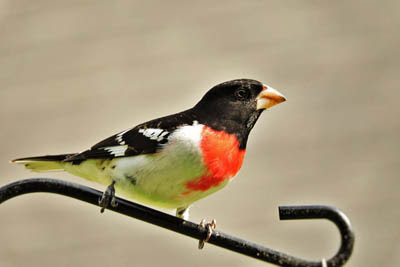 |
| Male Rose-breasted Grosbeak. Susan Killian. Pixabay. |
Males have black hood and upper parts. White under parts. Large white wing patches. Huge pink bill. Inverted bright red triangle on the breast.
Females are brown above, face with broad stripes, white throat. The under parts are buff with many thin brown streaks. Pale bill.
These birds inhabit deciduous and mixed forests. Shade trees in town. Come to feeders.
Rose-breasted Grosbeaks are summer residents throughout Pennsylvania.
Purple Finch
Forest finches of the foothills, delicately frosted in pinkish-red.
 |
| Male Purple Finch. Greg Gillson. |
Told from more common House Finch by bigger square or peaked head, bigger bill, lacks sharp striping below, deeply notched tail. Red covers all plumage.
Females lack red color, shows strongly patterned dark ear patch outlined all around with a pale stripe, is heavily streaked below.
Found in foothills and damp mountains conifers and mixed woods. Visit feeders, but less frequently than House Finches.
Purple Finches are year-round residents throughout most of Pennsylvania, winter visitors only in the southeast and southwest corners of Pennsylvania.
Ruddy Duck
These small ducks are dark rusty-orange in spring.
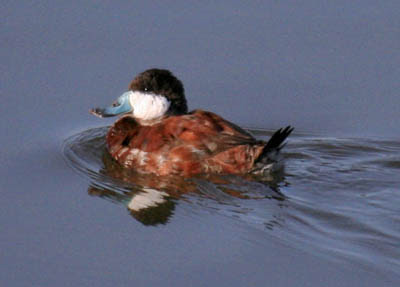 |
| Ruddy Duck. Greg Gillson. |
Males in breeding plumage (late winter and spring) are rusty, with a white face, and a blue bill. The long tail is often held sticking up. In winter they are brown, with white face, and dark bill.
Females all year are like winter males. Brown body, dark cap, dark line through eye of pale face. Dark bill.
These birds prefer weedy ponds to breed, but in winter may be found in deeper ponds in city parks.
Ruddy Ducks are winter visitors throughout Pennsylvania.
Orange birds of Pennsylvania
True orange-colored birds are not that common. Many birds that I have here are paler rusty.
The common pattern is an orange body and black or brown wings and tail. Another common pattern is for the orange to be restricted to the under parts.
The following are orange birds that you are most likely to see in Pennsylvania.
Eastern Towhee
These birds with rusty-orange sides like to hide in dense bushes.
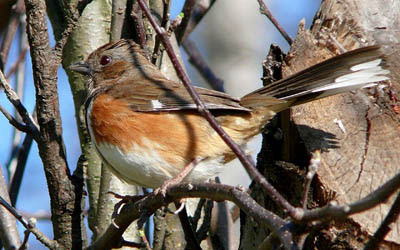 |
| Female Eastern Towhee. Skeeze. Pixabay. |
Males are black above with white wing patch, white tail corners. The sides are rusty. The belly white. Eyes variable: brown, red, orange, white, tending toward whiter southward.
Females are similar, but upper parts brown.
These birds are found in forest understory, dense brush, backyard hedges. Come to feeders.
Eastern Towhees are summer residents throughout Pennsylvania.
Barn Swallow
These orange-bellied birds are a familiar sight across North America in summer.
 |
| Barn Swallow. Greg Gillson. |
These birds are purple-blue above with orange under parts and long forked tails. The color of the underparts in winter or on females are often cinnamon or buff-colored, but breeding males can be brighter orange-red.
These birds swoop low over fields and wetlands at lower elevations. They may build their mud nests in rafters on porches, garages, or other out-buildings.
Barn Swallows are summer residents throughout Pennsylvania.
Wood Thrush
These spotted birds with the orange-brown upper parts tend to hide in understory trees and on the forest floor.
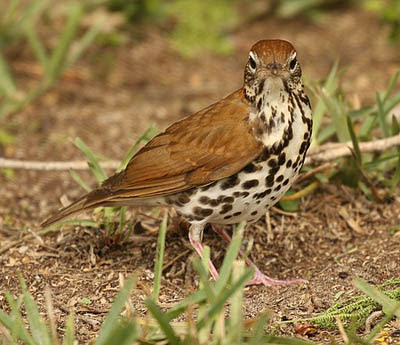 |
| Wood Thrush. Tony Castro. CC BY-SA 4.0 |
These birds are reddish brown on the upper parts, especially rusty orange on the crown and upper back. White eye ring. Large heavy black spots on the under parts.
They live in deciduous and mixed woods. Spend much time on the ground, shuffling through the leaf litter.
Wood Thrushes are summer residents throughout Pennsylvania.
Baltimore Oriole
These bright orange and black birds are fairly common breeders in wooded areas in the East.
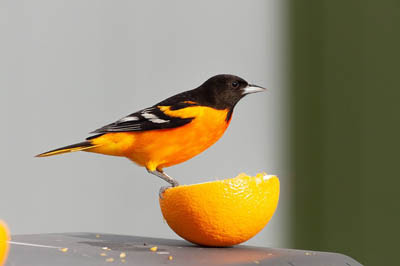 |
| Baltimore Oriole. Michael McGough. Pixabay. |
Males are have a black hood and back. Wings black with white patches. Tail black with orange sides to the base. Bright orange under parts.
Females are similar to males, but more olive above, less black. Immature birds for their first year or more are olive above orangish-yellow on the breast, fading to yellow on the belly. Two white wing bars.
These birds are common in deciduous woods, shade trees.
Baltimore Orioles are summer residents throughout Pennsylvania.
American Redstart
In flight these small warblers flash orange or yellow in the wing and based of the tail.
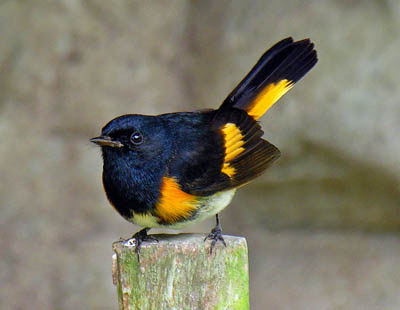 |
| American Redstart. Dennis Jarvis. Flikr. CC BY-SA 2.0 |
Males are black above, white on the belly. They have bright orange patches on side of breast, wings, and base of the tail.
Females are grayer, especially on the head. The orange of males is replaced by yellow on the females.
These birds are found in regenerating woods after a clear cut, and willow tangles along streams.
American Redstarts are summer residents throughout Pennsylvania.
Brown Thrasher
These are rather large rusty-orange songbirds.
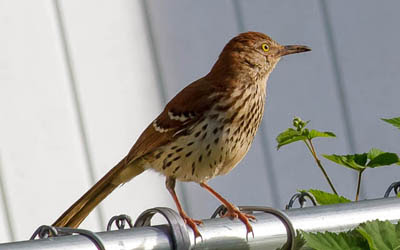 |
| Brown Thrasher. Linda Jones CC0. |
The upper parts of these birds is colored rusty-brown to orange. They show two white wing bars. Under parts are buff with heavy reddish-brown streaking.
These birds live in woodland edges and mature backyard landscaping.
Brown Thrashers are summer residents throughout Pennsylvania.
Red-breasted Nuthatch
These active little red-breasted birds crawls all around on the trunk and big branches of conifers. They search crevices in the bark for insect food.
 |
| Red-breasted Nuthatch. Greg Gillson. |
These tiny birds have blue-gray backs and a black line through a white face. Some males can have quite bright rusty red under parts. Some females can have quite pale buff-colored under parts. Most birds show an orange-cinnamon breast color.
Found nearly exclusively in conifers. Readily come to feeders.
Red-breasted Nuthatches are year-round residents throughout most of Pennsylvania, winter visitors only in southeast and southwest Pennsylvania.
Orchard Oriole
Males of these orioles are darker rustier-orange than most other orioles in the United States.
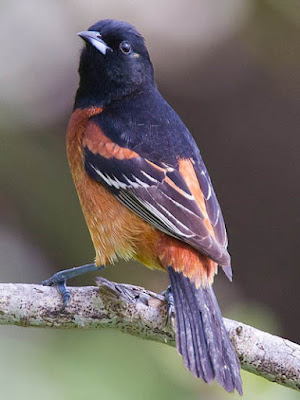 |
| Orchard Oriole. Dan Pancamo. Flikr. CC BY-SA 2.0 |
Males have a black hood and back, black wings and tail. The under parts are rusty-orange or even chestnut-brown.
Females are greenish above, lemon yellow below. They have 2 thin white wing bars. The bill is thinner than many other orioles.
They are found in orchards and residential shade trees.
Orchard Orioles are summer residents throughout Pennsylvania.
Red-shouldered Hawk
Okay, the shoulders are reddish. But the rusty-orange breast and wing linings are barred red too.
 |
| Red-shouldered Hawk. Greg Gillson. |
The upper parts are barred black and white. The tail is banded black and white. In adults the breast is barred orange.
Immature birds are streaked with brown on the breast.
These birds like woodland edges, residential edges, riparian groves.
Red-shouldered Hawks are year-round residents in the eastern half of Pennsylvania and the northwestern corner of the state. They are summer residents only in most of the western half of Pennsylvania.
Yellow birds of Pennsylvania
Yellow is a common bird color! Often it is mixed with black and white plumage in birds.
Many birds with darker upper parts have yellow breast or belly.
The following are yellow birds you are most likely to see in Pennsylvania.
American Goldfinch
These small little birds are bright yellow and black.
 |
| American Goldfinch. Greg Gillson. |
Males are bright lemon yellow with black and white wings and tail, black cap. White under tail coverts. Pink bill.
Females are duller yellow below and brownish above. Lack black cap.
Winter birds are pale brown or gray, a touch of yellow on the throat of males.
These are birds of open country, fields with saplings, clear cuts, residential areas. They avoid dense forests, mountains, deserts. They visit feeders.
American Goldfinches are year-round residents throughout Pennsylvania.
Northern Flicker
These woodpeckers spend much time eating ants on the ground.
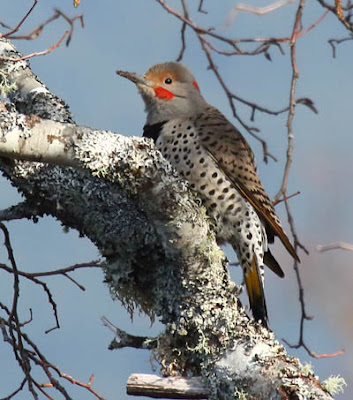 |
| Northern Flicker. Greg Gillson. |
These birds are larger than robins with brown and black barred upper parts. The underparts are pink with round black spots. There is a black crescent across the chest. When they fly away from you they reveal a large white rump.
Western birds have salmon-red under wings and under tail. Those in the East are colored yellow. The male face differs between the two populations–black whisker on the eastern birds, red whisker on western birds. Intergrades from overlap on Great Plains common. These may show male facial characteristics of both populations, or yellow-orange flight feathers.
These birds live in open woods with bare ground for foraging, residential yards.
Northern Flickers are year-round residents throughout Pennsylvania.
Common Yellowthroat
These buttery yellow birds are abundant in the marsh vegetation.
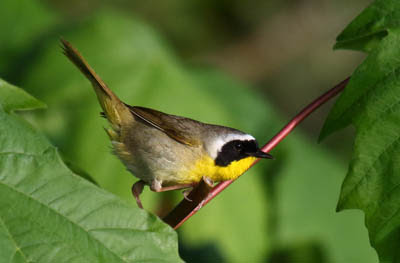 |
| Male Common Yellowthroat. Greg Gillson. |
These skulkers have bright yellow throats and yellow undertail coverts. Males have a black domino mask edged broadly in white, which females lack. Upperparts are dull olive-green.
Immature males in fall show a shadowed black mask.
Found in damp situations and heavy deciduous brambles following clear cuts.
Common Yellowthroats are summer residents throughout Pennsylvania.
Cedar Waxwing
These crested birds with yellow band on the end of the tail are often found in flocks. They eat flying insects in summer, fruit and berries the rest of the year.
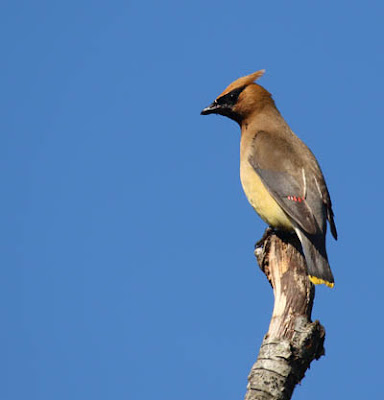 |
| Cedar Waxwing. Greg Gillson. |
These birds are fawn-brown above, with dark gray wings and tail. They have a black mask and wispy crest. The belly is yellow. The wings have waxy red drops on the end of the tertials. The end of the tail has a brilliant yellow tail band.
They are found in open habitats with berries, including juniper woodlands and towns in winter.
Cedar Waxwings are year-round residents throughout Pennsylvania.
Yellow Warbler
The golden yellow sun packed all into one little bird! Appears to be an all-yellow bird.
 |
| Yellow Warbler. Greg Gillson. |
Some populations are bright yellow, some tend toward greenish on upper parts, some more golden. Yellow internal tail corners in flight.
Males with red breast streaking, again, variable by population.
Females somewhat to much paler yellow, some greenish, some whitish. Lack red streaks.
These birds are found in willow thickets on the edge of wetlands and ditches, stream sides in arid regions.
Yellow Warblers are summer residents throughout Pennsylvania.
Yellow-rumped Warbler
These are abundant warblers across North America. Affectionately called “butter butts” by many birders, because of their bright yellow rumps that flash in flight.
 |
| Winter Yellow-rumped Warbler. Greg Gillson. |
Western form (Audubon’s) with bright yellow throat and yellow rump. Large white wing patch.
Northern and Eastern form (Myrtle) with white throat, yellow rump, and two white wing bars.
Winter birds are dull gray brown, with bright yellow rump. Throat may be cream colored or white. Often difficult to tell the two forms apart in winter.
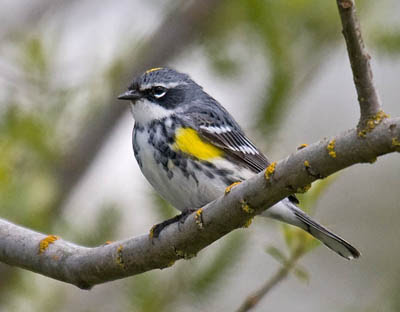 |
| Summer Yellow-rumped (Myrtle) Warbler. Greg Gillson. |
Breed in mountain or boreal conifers. Widespread in migration. Winter in low river bottoms, open weedy deciduous areas. Rarely come to feeders in winter.
Yellow-rumped Warblers are summer residents in northern Pennsylvania, winter visitors in southeast Pennsylvania, and spring and fall migrants only through southwestern Pennsylvania.
Great Crested Flycatcher
These flycatchers have long tails and big heads with big bill and bright yellow belly.
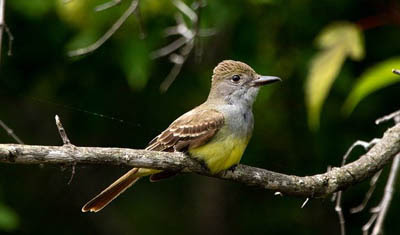 |
| Great Crested Flycatcher. Simard Francois. Pixabay. |
These birds are gray on the face and breast, brownish on rest of upper parts. Bright lemon yellow belly. The under side of the tail and some feathers of the wing are cinnamon colored.
These birds stay in the canopy of open woods.
Great Crested Flycatchers are summer residents throughout Pennsylvania.
Magnolia Warbler
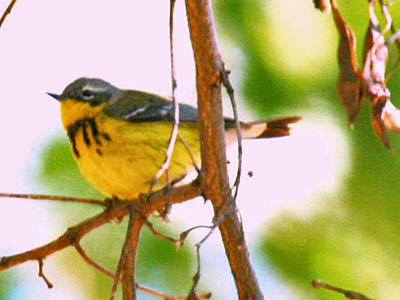 |
| Magnolia Warbler. Greg Gillson. |
Adult males are gray and black above and bright yellow below. Black mask and lower face. Gray crown. Black upper back. Black necklace that breaks into streaks down the breast. White under tail coverts. White under tail base, black terminal tail feathers. Large white wing patch.
Female with two wing bars, black mostly replaced with olive. Immatures for the first year lack black markings.
Live in moist coniferous forests, young stands of spruce and hemlock.
Magnolia Warblers are summer residents through northern and western Pennsylvania, spring and fall migrants only in southeastern Pennsylvania.
Hooded Warbler
These birds are found low down in the forest understory. They flash white tail corners.
 |
| Male Hooded Warbler. Christopher O’Toole. Pixabay. |
Males are dark green above with a black cowl over the crown and onto the throat. Face and under parts are bright yellow. White tail corners.
Females are similar, but lack the black of the male. The crown is green and the throat yellow.
These birds are found in deciduous woods and swamps, primarily in brushy understory.
Hooded Warblers are summer residents throughout Pennsylvania.
Pine Siskin
These small brown-streaked birds are relatives of the goldfinches. But you would never know it until they fly and sport yellow wing stripes and tail base. Usually in flocks.
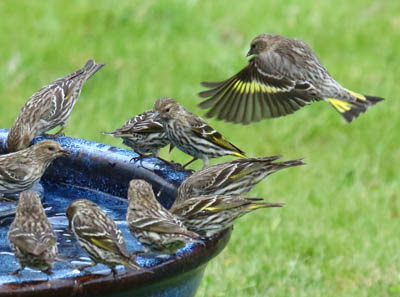 |
| Pine Siskin. Greg Gillson. |
These birds are streaked brown. In flight they have a yellow stripe down the length of the wing. The sides of the base of the tail is also yellow. Some birds are paler, some darker, others brighter yellow, others duller.
These birds are found in summer in northern conifer woods. Irregularly irrupt hundreds of miles southward. Frequent at feeders.
Pine Siskins are winter visitors throughout Pennsylvania.
Eastern Meadowlark
These pale brown birds with the brilliant yellow breasts are home on the ground in prairies. They sing from perches on isolated trees, power poles, fence posts.
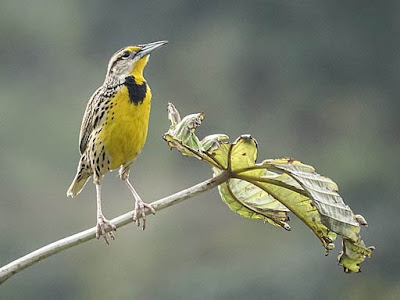 |
|
Eastern Meadowlark
Photo by Mike’s Birds from Riverside, CA, US [CC BY-SA 2.0]
|
The upper parts are streaked black, white, brown, so they blend into the dried grass where they live. The under parts are bright yellow with a black necklace across the chest. Very similar to Western Meadowlark, best told apart by spring song.
These birds live in prairies and extensive pasture lands.
Eastern Meadowlarks are summer residents throughout Pennsylvania, year-round residents in southeastern and northwestern Pennsylvania.
Yellow-throated Vireo
Vireos are slow moving small birds that sing throughout the day. These yellow-headed vireos are one of the most colorful of their clan.
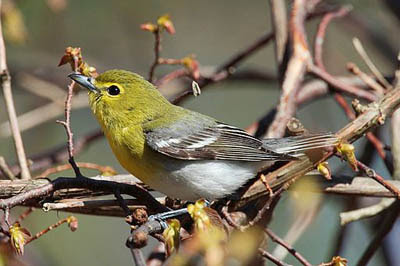 |
| Yellow-throated Vireo. MDF. CC BY-SA 3.0 |
These birds are blue-gray above, white below. Two white wing bars. Their head is olive yellow with yellow spectacles around the eye, and bright yellow throat.
These birds like large tracts of unbroken deciduous or mixed woodlands. Interestingly, however, they are often found on forest edges.
Yellow-throated Vireos are summer residents throughout Pennsylvania.
Wrapping Up
Pennsylvania boasts a vibrant collection of colorful birds, gracing its forests, grasslands, and backyards with their stunning plumage. While many have some red, orange and yellow plumage, there are plenty of others with bright colors. Here are some of the most eye-catching feathered friends you might encounter in the Keystone State:
Northern Cardinal: Arguably the Pennsylvania state bird, males flash a breathtakingly bright red coat, a sharp contrast to the females’ softer brown hues. Both sexes sport a black mask and a striking black beak.
Eastern Bluebird: These charismatic songbirds bring a splash of azure to the skies with their cerulean blue backs and rusty orange chests. Females exhibit paler tones, but both sexes adorn their wings with a white bar and bright pink throats.
Indigo Bunting: Males steal the show with their deep, iridescent indigo feathers, shimmering like polished gems. Females wear a more subdued brown coat, but both sexes boast bright white wing bars and delicate white edges on their tail feathers.
Scarlet Tanager: These summer visitors paint the trees with their fiery red plumage, especially striking against the lush green foliage. Females display a subtler yellow-green back with black wings and olive streaks.
American Goldfinch: These gregarious finches brighten gardens and fields with their vibrant yellow bodies tinged with olive on their backs and wings. Males sport a distinctive black cap and black wing bars, while females showcase a more golden crown and pale streaking.
Cedar Waxwing: These elegant birds boast a unique combination of soft gray hues, punctuated by bright yellow wing tips and a vibrant red waxy tip on their tail feathers. Their black masks and beady black eyes add a touch of intrigue to their graceful appearance.
Baltimore Oriole: These dazzling songbirds bring a tropical-like vibe to Pennsylvania in summer. Males sport a fiery orange body ablaze with black wings and head, while females showcase a more muted yellow chest and olive back.
Yellow Warbler: These charming warblers flit through trees and bushes, sporting a bright yellow body accented by olive wings and a distinctive white wing bar. Males boast a chestnut streaked breast, while females display a paler yellow tone.
Black-throated Blue Warbler: These tiny dynamos pack a punch with their bold color pattern. Males flash a stunning blue head and back, contrasted by a jet-black throat and white wing bars. Females wear a grayer head and back with a yellow throat, but both sexes share the impressive wing markings.
Louisiana Waterthrush: These lively riparian birds weave through streamside vegetation, displaying a slate-blue back and head alongside a bright white breast and crisp yellow eyebrow stripe. Both sexes share this striking pattern, making them unmistakable near water.
Frequently Asked Questions
What kind of bird has a red chest in Pennsylvania?
The Pine Grosbeak is a rare visitor to Pennsylvania and you are a very lucky person if you see one. Here are my tips for finding them:
Northern Pennsylvania: The northernmost regions, particularly near the Allegheny National Forest, offer the best chance for encountering these elusive birds. They might be found in coniferous forests, especially stands of spruce and fir, during the winter months.
High elevations: Pine Grosbeaks prefer colder environments, so seeking them at higher elevations like mountaintops or ridges within suitable habitat might increase your chances.
Winter: Pine Grosbeaks migrate south from Canada during the coldest months, typically arriving in Pennsylvania between November and March. Their sightings are most likely during this period.
Irruptions: Some years experience “irruptions” where large numbers of these birds move southward due to poor seed and cone crops in their northern breeding grounds. During these sporadic years, sightings become more frequent, even in unlikely locations.
What is the orange bird with black wings Pennsylvania?
The Scarlet Tanager can sometimes appear orange! While their namesake suggests a vibrant red plumage, in reality, their color can vary quite a bit across different situations and stages of life. Here’s a breakdown of the orange variations you might encounter:
First-alternate males: These young males, in their first breeding season (one year old), often display a more orange-red hue compared to mature adults. Their feathers haven’t fully developed the rich, fiery red color that older males boast. This orange-red shade can sometimes appear closer to orange, especially in certain lighting conditions.
Individual variations: Even among mature males, there can be natural variations in the shade of red. Some individuals might naturally lean towards a slightly orange-tinged red, while others exhibit a deeper, more crimson hue. These variations depend on genetics and individual pigment production.
Lighting and viewing angle: The way light falls on the feathers and the angle from which you observe the bird can also influence its perceived color. Sunlight filtering through leaves might cast a warm yellow glow, giving the reddish feathers an orange tint. Similarly, viewing the bird from behind might emphasize the yellow undertones in their plumage, contributing to a more orange appearance.
Winter plumage: While primarily seen in breeding season, Scarlet Tanagers also sport a duller winter plumage. Their red feathers become faded and muted, sometimes appearing closer to a rusty orange or brownish red. This winter coat offers them better camouflage when food resources are scarce and competition is lower.
What is the yellow bird in Pennsylvania?
Here are some possibilities to consider:
American Goldfinch: These gregarious finches are entirely yellow in summer, with black wings and a black cap in males. Females exhibit a more olive back and wings.
Yellow Warbler: These active warblers have a bright yellow body with olive wings and a white wing bar. Males usually have a chestnut streaked breast, while females have a paler yellow chest.
Related Articles:
See photos and learn about the most common backyard birds in Pennsylvania, regardless of color.
See photos and learn what to feed winter birds in Pennsylvania.
Here’s a quick tutorial of how I would teach you to identify birds: 7 Steps to Identify Birds!
Birds with red heads in North America.
Yellow-and-black birds in North America.








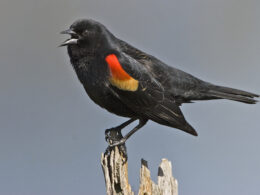


I LOVE this article! You've made me want to get a book on birds of PA and start identifying the birds in my neighborhood! I was looking up birds in PA because I wanted to know what a bird was I saw in thr tree across the street from my house. It is a Baltimore Oriole and is Gorgeous! Thank you!–Debbie Lindemann
Wow! A Baltimore Oriole is a beautiful bird.
The bird that starts you on your bird watching journey is often called your Spark Bird.